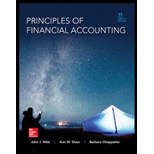
1. a.
Compute the amount of
1. a.
Explanation of Solution
Stock dividends: Stock dividends are the number of shares issued by a company to the existing shareholders in a proportion equal to the number of shares owned by each shareholder, based on a stock dividend percentage.
Compute the amount of retained earnings after the stock dividend shares are issued.
Step 1: Compute number of stock dividend shares.
Step 2: Compute stock dividends amount.
Note: Refer to Equation (1) for value and computation of stock dividend shares.
Step 3: Compute retained earnings value after stock dividend issue.
| Particulars | Amount ($) |
| Retained earnings before stock dividend | $660,000 |
| Less: Stock dividend issue | 250,000 |
| Retained earnings after stock dividend issue | $410,000 |
Table (1)
Thus, the amount of retained earnings after the stock dividend was $410,000.
1. b.
Compute the amount of
1. b.
Explanation of Solution
Compute the amount of stockholders’ equity after the stock dividend shares are issued.
| Corporation S | |
| June 30, 2015 | |
| Particulars | Amount ($) |
| Paid-in Capital: | |
|
Common stock, $10 par value, 120,000 shares authorized, 75,000 shares issued and outstanding | $750,000 |
| Paid-in capital in excess of par value | 200,000 |
| Total paid-in capital | $950,000 |
| Retained earnings | 410,000 |
| Total stockholders’ equity | $1,360,000 |
Table (2)
Thus, the amount of stockholders’ equity after the stock dividend is $1,360,000.
1. c.
Compute the number of outstanding shares after the stock dividend issue.
1. c.
Explanation of Solution
Outstanding stock: The total number of shares that are authorized and issued by a public company, and are held by the stockholders or investors are referred to as outstanding stock.
Compute the number of outstanding shares after the stock dividend issue.
| Particulars | Number of Shares |
| Issued and outstanding shares before stock dividend issue | 50,000 shares |
| Stock dividend shares | 25,000 shares |
| Outstanding number of shares after stock dividend issue | 75,000 shares |
Table (3)
Thus, the number of outstanding shares after the stock dividend issue are 75,000 shares.
2. a.
Compute the amount of retained earnings after the stock split.
2. a.
Explanation of Solution
Stock split: Stock split is the increase in number of shares due to splitting or decreasing par value of each share.
The amount of stock split neither increase nor decrease any of the capital accounts, but reduce the par value of shares and increase the number of shares. So, there would be no effect on retained earnings.
2. b.
Compute the amount of stockholders’ equity after the stock split.
2. b.
Explanation of Solution
Compute the amount of stockholders’ equity after the stock split.
| Corporation S | |
| Balance Sheet (Partial) | |
| June 30, 2015 | |
| Particulars | Amount ($) |
| Paid-in Capital: | |
|
Common stock, $6.67 par value, 180,000 shares authorized, 75,000 shares issued and outstanding | $500,000 |
| Paid-in capital in excess of par value | 200,000 |
| Total paid-in capital | $700,000 |
| Retained earnings | 660,000 |
| Total stockholders’ equity | $1,360,000 |
Table (4)
Working Notes:
Compute authorized number of shares after stock-split.
Compute outstanding number of shares after stock-split.
Compute the par value of shares after stock split.
Compute common stock value due to stock split.
Note: Refer to Equations (2) and (3) for value and computation of number of shares after stock split and par value of stock after stock split.
Thus, the amount of stockholders’ equity after the stock split is $1,360,000.
2. c.
Compute the number of outstanding shares after the stock split.
2. c.
Explanation of Solution
Compute the number of outstanding shares after the stock split.
| Particulars | Number of Shares |
| Issued and outstanding shares before stock split | 50,000 shares |
| Increase in number of shares after stock split | 25,000 shares |
| Outstanding number of shares after stock split | 75,000 shares |
Table (5)
Thus, the number of outstanding shares after the stock split are 75,000 shares.
3.
Describe the difference between a large stock dividend and stock split in a shareholder’s point of view.
3.
Explanation of Solution
Difference to a shareholder: There will be no difference for a shareholder if he receives either the stock dividend or stock split because the stockholder receives an increase in the number of shares for the proportion of shares owned.
Want to see more full solutions like this?
Chapter 13 Solutions
Principles of Financial Accounting.
- Under absorption costing what is total period costs?arrow_forwardNonearrow_forwardLiam Corporation had $8.5 million in gross income, operating expenses of $2.2 million, paid $1.8 million in interest on $15 million borrowed, and paid a dividend of $1.1 million. What is Liam Corporation's taxable income? a) $4.5 million b) $3.4 million c) $5.6 million d) $6.3 millionarrow_forward

 AccountingAccountingISBN:9781337272094Author:WARREN, Carl S., Reeve, James M., Duchac, Jonathan E.Publisher:Cengage Learning,
AccountingAccountingISBN:9781337272094Author:WARREN, Carl S., Reeve, James M., Duchac, Jonathan E.Publisher:Cengage Learning, Accounting Information SystemsAccountingISBN:9781337619202Author:Hall, James A.Publisher:Cengage Learning,
Accounting Information SystemsAccountingISBN:9781337619202Author:Hall, James A.Publisher:Cengage Learning, Horngren's Cost Accounting: A Managerial Emphasis...AccountingISBN:9780134475585Author:Srikant M. Datar, Madhav V. RajanPublisher:PEARSON
Horngren's Cost Accounting: A Managerial Emphasis...AccountingISBN:9780134475585Author:Srikant M. Datar, Madhav V. RajanPublisher:PEARSON Intermediate AccountingAccountingISBN:9781259722660Author:J. David Spiceland, Mark W. Nelson, Wayne M ThomasPublisher:McGraw-Hill Education
Intermediate AccountingAccountingISBN:9781259722660Author:J. David Spiceland, Mark W. Nelson, Wayne M ThomasPublisher:McGraw-Hill Education Financial and Managerial AccountingAccountingISBN:9781259726705Author:John J Wild, Ken W. Shaw, Barbara Chiappetta Fundamental Accounting PrinciplesPublisher:McGraw-Hill Education
Financial and Managerial AccountingAccountingISBN:9781259726705Author:John J Wild, Ken W. Shaw, Barbara Chiappetta Fundamental Accounting PrinciplesPublisher:McGraw-Hill Education





